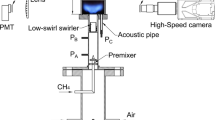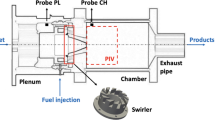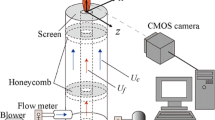Abstract
Analysis of dynamic combustor stability is essential for the development of practical devices that employ distributed reaction zones. The fluctuation of reaction zone (RZ) was studied to compare normal air combustion and distributed combustion at an equivalence ratio of 0.9 in a swirl-stabilized burner using methane fuel. Distributed combustion was fostered by diluting the inlet air stream with carbon dioxide that resulted in a gradual drop in the adiabatic flame temperature (Tad). High-speed broadband chemiluminescence at 3 kHz was used to study the global combustion dynamics. Vortex shedding observed along the shear layers influenced the oscillation of flame base in normal air combustion. However, relatively stable bases were observed in distributed combustion. Fast Fourier Transformation performed on RZ base fluctuation data supported the observations from chemiluminescence signatures. Proper orthogonal decomposition (POD) analysis indicated various vortex-shedding patterns as the dominant structures in conventional swirl flames. The power spectral density (PSD) of POD modes showed the rotational effect of RZ and weak von Karman vortex shedding to influence fluctuation in distributed combustion. The self-sustained flame oscillations in normal swirl flames were investigated from the acoustic and heat release fluctuation signals. Both acoustic and heat release fluctuations gradually reduced when approaching the distributed combustion. The PSD of these signals demonstrated a common peak at ~ 174 Hz (in normal swirl flames) with possible thermo-acoustic coupling. This peak was consistent with the peaks obtained from the base fluctuation and POD spectra. The peak gradually diminished when approaching the state of distributed combustion. A similar observation of gradually decreasing acoustic and heat release fluctuation was made with a constant Tad. However, the drop in chemiluminescence signal intensity with CO2 dilution was relatively low in case of constant Tad compared to the variable Tad case. The local and global Rayleigh index obtained for the variable Tad cases at different dilution levels showed positive values at O2 = 21 and 20%, which signified self-sustained instability. However, the distributed combustion possessed a negative Rayleigh index indicating dampening of instability. These results support the gradual decline of thermo-acoustic instability when approaching the distributed combustion condition.
Graphic abstract














Similar content being viewed by others
References
Arghode VK, Gupta AK (2011) Development of high intensity CDC combustor for gas turbine engines. Appl Energy 88(3):963–973. https://doi.org/10.1016/j.apenergy.2010.07.038
Arghode VK, Gupta AK, Bryden KM (2012) High intensity colorless distributed combustion for ultra-low emissions and enhanced performance. Appl Energy 92:822–830. https://doi.org/10.1016/j.apenergy.2011.08.039
Bahr DW (1991) Aircraft engines no emissions—abatement progress and prospects. Proceedings of Tenth International Symposium on Air-breathing Engines, Nottingham, England
Cavaliere A, de Joannon M (2004) Mild Combustion. Progress Energy Combust Sci 30(4):329–366. https://doi.org/10.1016/j.pecs.2004.02.003
Dawson JR, Rodriguez-Martinez VM, Syred N, O’Doherty T (2005) The effect of combustion instability on the structure of recirculation zones in confined swirling flames. Combust Sci Tech 177(12):2349–2371. https://doi.org/10.1080/00102200500241149
Durox D, Moeck JP, Bourgouin JF, Morenton P, Viallon M, Schuller T et al (2013) Flame dynamics of a variable swirl number system and instability control. Combust Flame 160:1729–1742. https://doi.org/10.1016/j.combustflame.2013.03.004
Fritsche D, Füri M, Boulouchos K (2007) An experimental investigation of thermoacoustic instabilities in a premixed swirl-stabilized flame. Combust Flame 151(1–2):29–36. https://doi.org/10.1016/j.combustflame.2007.05.012
Gupta AK, Lilley DG, Syred N (1984) Swirl Flows. Abacus Press, Gordon and Breach Publishers, Tunbridge Wells
Huang Y, Wang S, Yang V (2006) Systematic analysis of lean-premixed swirl-stabilized combustion. AIAA J 44(4):724–740. https://doi.org/10.2514/1.15382
Huang Y, Yang V (2009) Dynamics and stability of lean-premixed swirl-stabilized combustion. Prog Energy Combust Sci 35(4):293–364. https://doi.org/10.1016/j.pecs.2009.01.002
Kang DM, Culick FEC, Ratner A (2007) Combustion dynamics of low-swirl combustor. Combust Flame 151:412–425. https://doi.org/10.1016/j.combustflame.2007.07.017
Karyeyen S, Feser JS, Gupta AK (2019) Swirl assisted distributed combustion behavior using hydrogen-rich gaseous fuels. Appl Energy 251:113354. https://doi.org/10.1016/j.apenergy.2019.113354
Khalil AEE, Brooks JM, Gupta AK (2016) Impact of confinement on flowfield of swirl flow burners. Fuel 184:1–9. https://doi.org/10.1016/j.fuel.2016.06.098
Khalil AEE, Gupta AK (2014) Velocity and turbulence effect on high intensity distributed combustion. Appl Energy 125:1–9. https://doi.org/10.1016/j.apenergy.2013.11.078
Khalil AEE, Gupta AK (2017b) Acoustic and heat release signatures for swirl assisted distributed combustion. Appl Energy 193:125–138. https://doi.org/10.1016/j.apenergy.2017.02.030
Khalil AEE, Gupta AK (2017c) Flame fluctuations in Oxy-CO2-methane mixtures in swirl assisted distributed combustion. Appl Energy 204:303–317. https://doi.org/10.1016/j.apenergy.2017.07.037
Khalil AEE, Gupta AK (2017a) Towards colorless distributed combustion regime. Fuel 195:113–122. https://doi.org/10.1016/j.fuel.2016.12.093
Kim GT, Yooa CS, Chung SH, Park J (2020) Effects of non-thermal plasma on the lean blowout limits and CO/NOx emissions in swirl-stabilized turbulent lean-premixed flames of methane/air. Combust Flame 212:403–414. https://doi.org/10.1016/j.combustflame.2019.11.024
Moeck JP, Bourgouin J-F, Durox D, Schuller T, Candel S (2013) Tomographic reconstruction of heat release rate perturbations induced by helical modes in turbulent swirl flames. Exp Fluids 54:1498. https://doi.org/10.1007/s00348-013-1498-2
Oberleithner K, Stöhr M, Im SH, Arndt CM, Steinberg AM (2015) Formation and flame-induced suppression of the precessing vortex core in a swirl combustor: experiments and linear stability analysis. Combust Flame 162(8):3100–3114. https://doi.org/10.1016/j.combustflame.2015.02.015
Palies P, Ilak M, Cheng R (2017) Transient and limit cycle combustion dynamics analysis of turbulent premixed swirling flames. J Fluid Mech 830:681–707. https://doi.org/10.1017/jfm.2017.575
Rajasegar R, Mitsingas CM, Mayhew EK, Yoo J, Lee T (2016) Proper orthogonal decomposition for analysis of plasma-assisted premixed swirl-stabilized flame dynamics. IEEE Trans Plasma Sci 44(12):2940–2951. https://doi.org/10.1109/TPS.2016.2622687
Roy R, Gupta AK (2020) Flame structure and emission signature in distributed combustion. Fuel 262:116460. https://doi.org/10.1016/j.fuel.2019.116460
Smith GP, Golden DM, Frenklach M, Moriarty NW, Eiteneer B, Goldenburg M, et al. (1999) GRI 3.0 Mechanism, http://www.me.berkeley.edu/gri_mech/
Steinberg M (1999) Fossil fuel decarbonization technology for mitigating global warming. Int J Hydrogen Energy 24:771–777. https://doi.org/10.1016/S0360-3199(98)0012-1
Steinberg AM, Boxx I, Stöhr M, Meier W (2012) Effects of flow structure dynamics on thermoacoustic instabilities in swirl-stabilized combustion. AIAA J 50(4):952–967. https://doi.org/10.2514/1.J051466
Syred N (2006) A review of oscillation mechanisms and the role of the precessing vortex core (PVC) in swirl combustion systems. Progress Energy Combust Sci 32:93–161. https://doi.org/10.1016/j.pecs.2005.10.002
Syred N, Hanby VI, Gupta AK (1973) Resonant instabilities generated by swirl burners. J Inst Fuel 1973:402–407
Syred N, Gupta AK, Beér, JM (1975) Temperature and density gradient changes arising with the processing vortex core and vortex breakdown in swirl burners, Proc. 15th Symposium (Intl.) on Combustion, The Combustion Institute, p. 587–597. Doi: https://doi.org/10.1016/S0082-0784(75)80330-4
Tsuji H, Gupta AK, Hasegawa T, Katsuki M, Kishimoto K, Morita M (2003) High temperature air combustion: from energy conservation to pollution reduction. CRC Press, Boca Raton (Florida)
Weber R, Gupta AK, Mochida S (2020) High temperature air combustion (HiTAC): How it all started for applications in industrial furnaces and future prospects. Applied Energy 278:115551. https://doi.org/10.1016/j.apenergy.2020.115551
Zhu S, Acharya S (2013) Flame dynamics with hydrogen addition at Lean Blowout Limits. Proceedings of ASME Turbo Expo 2013: Turbine Technical Conference and Exposition Paper GT2013–95822, San Antonio, Texas. DOI: https://doi.org/10.1115/GT2013-95822
Acknowledgements
The authors gratefully acknowledge the generous research support provided by the Office of Naval Research (ONR), USA.
Author information
Authors and Affiliations
Corresponding author
Additional information
Publisher's Note
Springer Nature remains neutral with regard to jurisdictional claims in published maps and institutional affiliations.
Supplementary Information
Below is the link to the electronic supplementary material.
Supplementary file2 (AVI 8054 KB)
Supplementary file3 (AVI 12478 KB)
Rights and permissions
About this article
Cite this article
Roy, R., Gupta, A.K. Experimental investigation of flame fluctuation reduction in distributed combustion. Exp Fluids 62, 62 (2021). https://doi.org/10.1007/s00348-021-03168-w
Received:
Revised:
Accepted:
Published:
DOI: https://doi.org/10.1007/s00348-021-03168-w




